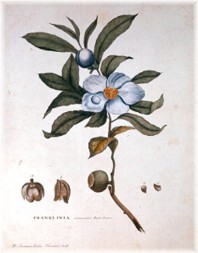Franklinia: The Lost Camellia
By Audrey Stallsmith

On drawing near the fort I was greatly delighted at the appearance of two beautiful shrubs in all their blooming graces. One of them appeared to be a species of Gordonia, but the flowers are larger, and more fragrant than those of the Gordonia lasianthus. . .we never saw it grow in any other place, nor have I ever seen it growing wild in all my travels.”
Travels—William Bartram
What avid gardener hasn’t dreamed of discovering and/or introducing a new plant or two? In the 1700’s a Quaker named John Bartram, who lived near Philadelphia, had a whole New World to explore. He sent seeds for at least 200 species of plants back to England and also laid out the first botanical garden in America.
A farmer and amateur physician who chose to study botany, John had a long correspondence with London textile dealer named Peter Collinson. The latter set up a subscription scheme among his wealthier plant-loving friends, each of whom paid five guineas per year to receive boxes of seeds from America. Eventually Collinson even got Bartram named King’s Botanist to George III, at a salary of 50 pounds per year.
This allowed Bartram to take the trip of which he’d always dreamed into the deep South. It was on that journey in 1765 that John and his son William discovered the tree for which they are most remembered, and which remains—ironically enough—among the most obscure.
They found Franklinia altamaha growing along the Altamaha River near Fort Barrington in Georgia, and eventually named it for that location as well as for their friend, Benjamin Franklin. The stand of trees was still there during William Bartram’s later Travels (1773-1777), and when John’s cousin, Moses Marshall—author of the Arbustrum Americanum--took his own trip south in 1790.
But, by the early 1800’s, the wild specimens of franklinia had completely disappeared. A member of the tea family, it is often known as the “lost camellia,” and the Bartrams are credited with saving the tree from complete extinction. All of the franklinias in America today are believed to be descended from the one John planted in his own garden.
As it looked quite similar to the loblolly pine, which had been dubbed Gordonia lasisanthus after British nurseryman James Gordon, franklinia was known for a time as Gordonia pubescens—in reference to its fuzzy seedpods. But eventually botanists discovered that, although the flowers were similar, the fruits were quite different.
Franklinia is a somewhat curious tree, in that it has bark “like a greyhound’s skin,” and often continues to produce its two to three-inch white flowers long after its leaves have fallen. So it almost looks like a fall-blooming magnolia. And, although originally discovered in Georgia, it actually seems to grow better in more northern climes.
After the beginning of the Revolutionary War, John worried about what would happen to his garden. And, as the British general Howe entered Philadelphia, Alice Coats writes in the Plant Hunters, “the old botanist departed.” Departed this life, she meant. But he had certainly done much to enrich the lives of those he left behind.
William became famous in his own right as the author of Travels, and carried on his father’s work. Today, Bartram’s Garden--now owned by the city of Philadelphia--is still in existence as part of Fairmont Park.
Meanwhile the “lost camellia” continues to grow, in gardens now rather than the wild. Symbolic, perhaps, of a wild country now tamed. And a lasting legacy to the family who introduced the mysterious plants of the New World to the Old.
Franklinia image is by William Bartram.








